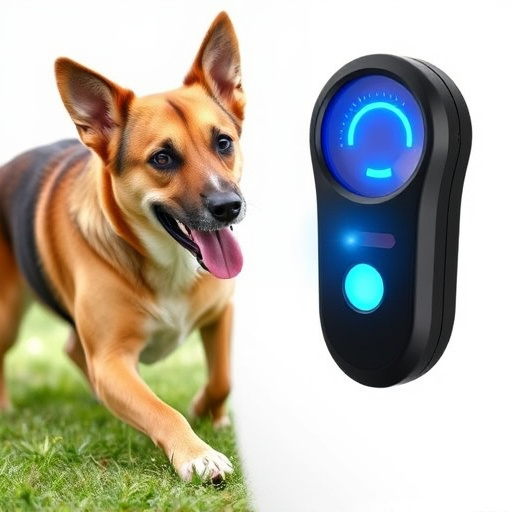Dog aggression triggers require understanding for personal safety. Training and socialization mitigate fear, territoriality, and past trauma responses. FDA-approved dog repellent devices emit safe signals to disrupt aggressive behavior without harm. Topical repellents containing capsaicin deter dogs through non-lethal means. Positive reinforcement training deters violence while strengthening owner-pet bond. Strategic home security measures reduce dog encounters. Local regulations and resources, including FDA-approved devices, enhance protection against aggressive dogs.
Personal protection from aggressive dogs is a crucial concern, especially as dog bites can have severe physical and emotional repercussions. This comprehensive guide explores various strategies to safeguard yourself and your loved ones. We delve into understanding the triggers of dog aggression, prevention techniques, and non-violent training methods. Additionally, we discuss creating secure homes, leveraging community resources, and the role of FDA-approved topical repellents in mitigating risks.
- Understanding Dog Aggression Triggers and Prevention
- FDA Approved Topical Repellents for Dog Protection
- Non-Violent Training Methods to Deter Aggressive Behaviors
- Creating a Safe Space: Home Security Measures Against Dogs
- Community Resources and Laws for Dog Bite Prevention
Understanding Dog Aggression Triggers and Prevention
Understanding dog aggression triggers is paramount in personal protection. Many aggressive behaviors stem from fear, territoriality, or past traumatic experiences. For instance, a dog may react aggressively when feeling threatened by strangers, other animals, or sudden movements. Training and socialization can mitigate these triggers by teaching dogs to recognize and respond calmly to such stimuli. Regular exposure to diverse environments and people helps normalize their reactions.
Preventative measures are equally vital. Using FDA-approved dog repellent devices can be effective in deterring aggressive behavior without causing harm. These devices emit safe, non-toxic signals that disrupt a dog’s aggression pattern by temporarily distracting or disorienting them. Incorporating these tools into your strategy alongside behavioral training can significantly enhance personal safety when encountering potentially aggressive dogs.
FDA Approved Topical Repellents for Dog Protection
When it comes to protecting yourself from aggressive dogs, one effective option is the use of FDA-approved topical repellents. These devices offer a non-lethal and safe alternative to deterring unwanted canine interactions. Formulated with active ingredients like capsaicin, which is derived from chili peppers, these repellents create an unpleasant sensation for dogs when they come into contact with the skin. This sensory deterrent helps keep dogs at bay without causing them any harm.
The market offers various FDA-approved dog repellent devices, each designed to meet different needs and preferences. From spray bottles to roll-on applications, these products provide convenient and portable solutions for outdoor activities or when traveling in areas known for having aggressive dog populations. Regular application according to the product instructions ensures maximum effectiveness in keeping dogs at a safe distance.
Non-Violent Training Methods to Deter Aggressive Behaviors
Training methods that avoid violence are effective in deterring aggressive dog behaviors. Positive reinforcement, a popular approach, encourages desired behaviors by rewarding them with treats or praise. This method strengthens the bond between owner and pet while promoting good behavior. Additionally, desensitization techniques help dogs become comfortable with various stimuli, reducing their tendency to react aggressively.
Another humane option are FDA-approved dog repellent devices designed to discourage unwanted behavior without causing harm. These tools use safe methods like citronella sprays or high-frequency sounds that are unpleasant for dogs but non-toxic and harmless. Incorporating these non-violent strategies into training routines can transform a dog’s demeanor, fostering a safer environment for both the pet and its human companions.
Creating a Safe Space: Home Security Measures Against Dogs
Creating a safe space at home is paramount when dealing with aggressive dogs, and there are several security measures you can implement to achieve this. Starting with robust fencing, ensure it’s tall enough (at least 6 feet) and well-maintained to prevent any unwanted intrusions from four-legged visitors. Additionally, installing FDA-approved dog repellent devices can be highly effective. These innovative tools use ultrasonic sounds or safe spray deterrents to discourage dogs without causing harm, making them ideal for homes with children or other pets.
For added protection, consider securing your trash cans with tight-fitting lids and keep your property clean and free of food sources that might attract stray dogs. Lighting is another powerful tool; well-lit areas act as a deterrent, so ensure strategic placement of outdoor lights around your home’s perimeter. By combining these measures, you can significantly reduce the risk of aggressive dog encounters within your safe, secure space.
Community Resources and Laws for Dog Bite Prevention
Many communities have resources and laws in place to help prevent dog bites and protect individuals. Local governments often regulate dog ownership, licensing, and registration, which can include specific requirements for aggressive dogs. These regulations may involve mandatory training programs, restricted off-leash areas, or even mandatory microchipping.
Additionally, there are FDA-approved dog repellent devices available that use safe, non-toxic methods to deter aggressive behavior. These innovative solutions, such as ultrasonic repellents or spray-based deterrents, can be effective tools in personal protection. By utilizing these resources and adhering to local laws, individuals can enhance their safety when encountering potentially dangerous dogs.
Personal protection from aggressive dogs involves a multi-faceted approach. By understanding dog aggression triggers, utilizing FDA-approved topical repellents, employing non-violent training methods, creating safe spaces at home, and leveraging community resources and laws, you can significantly reduce the risk of dog bites. Remember that prevention is key, and with the right strategies in place, you can enjoy a safer environment for both yourself and others. Consider these measures as part of your comprehensive strategy to protect against aggressive dogs.
